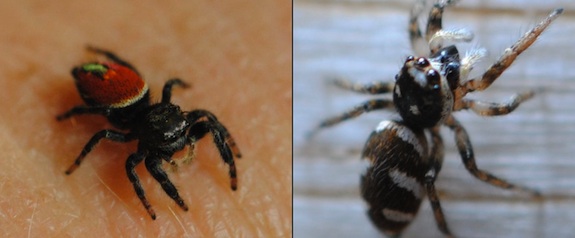Spidernaut Returns Home From Space
After a 99-day at the space station, a red-backed jumping spider comes to the Natural History Museum
![]()

The Natural History Museum’s new red-backed jumping spider made a 99-day mission in space, accompanied by a zebra spider. Image courtesy of NASA, BioServe
After living on the International Space Station for 99 days, the only living “spidernaut” in the world has found a new home at the Natural History Museum. Museum director Kirk Johnson, associate director Jonathan Coddington and Insect Zoo acting manager Dan Babbitt welcomed the eight-legged space cadet Thursday with a crowd of curious children.
The red-backed jumping spider, or Phidippus johnsoni, was part of an experiment designed by 18-year-old Amr Mohamed of Alexandria, Egypt. After winning a worldwide contest, his study was selected to test the effects of a microgravity environment on the spider’s hunting technique. The spider, nicknamed the Jumping Johnson, relies on its spring-powered legs to track down prey. Observations by NASA astronaut Sunita Williams aboard the space station showed that the spider was able to adjust to the new environment.
But what one young girl in the crowd really wants to know is, “Do they jump on people?”
Coddington confirms that, yes, they often do. Though they don’t get much bigger than one centimeter, the spiders are still one of the largest jumping species in North America and can show up at picnics.
The red-backed jumping spider will now be part of the museum’s Insect Zoo after successfully readjusting to life on Earth.
Meanwhile, a consensus was reached on how cool exactly the tarantula feeding to follow the spider’s homecoming presentation is: very cool.
/https://tf-cmsv2-smithsonianmag-media.s3.amazonaws.com/accounts/headshot/Leah-Binkovitz-240.jpg)
/https://tf-cmsv2-smithsonianmag-media.s3.amazonaws.com/accounts/headshot/Leah-Binkovitz-240.jpg)